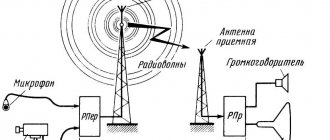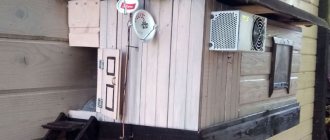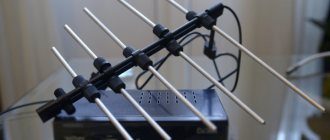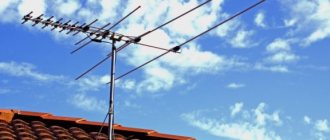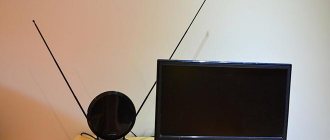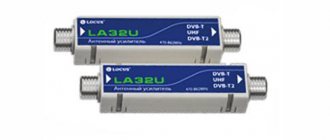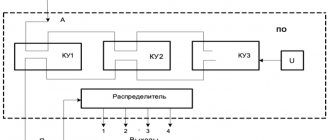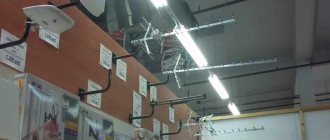Russia will completely abandon analog television from January 1, 2019. To connect to free digital terrestrial television, you need to have a modern TV (or buy a special digital set-top box for your old TV), as well as an individual UHF antenna.
How owners of televisions with a built-in tuner can switch to digital TV - in the material of RIA Voronezh, prepared jointly with the chief engineer of the Voronezh Regional Radio and Television Transmission Center (ORTPTs) Alexander Khizhko.
Photo – courtesy of Voronezh ORTPS
Do I need a special antenna for digital reception?
There are no special “digital” antennas. To receive a digital terrestrial television signal, it is necessary to use UHF antennas (UHF, UHF, bands IV-V, 470-790 MHz, channels 21-60). Suitable, for example, is a log-periodic antenna or a “wave channel” antenna of the UHF range. Outdated meter range antennas (MV, VHF, bands I-III, 47¬-230 MHz, channels 1-12) cannot receive digital signals efficiently.
What cable is needed for the antenna?
The antenna is connected to the TV using a coaxial cable, which is often included. But if the antenna is purchased without a cable or the cable is not long enough, then it is important to take into account several nuances.
For TV antennas, it is necessary to use a cable with a characteristic impedance of 75 Ohms. This parameter is indicated on the product itself.
The longer the cable, the greater the signal attenuation during transmission. The length of an indoor antenna cable with a diameter of 3-5 mm should not exceed 2 m. A cable with a diameter of 6-7 mm can have a length of up to 10-15 m, and a cable of 9-11 mm can have a length of up to 20 m. If it is necessary to use a long cable, it is advisable to use an active antenna (more about it below) - with a built-in electronic signal amplifier. In this case, compensation of losses in the cable occurs.
The quality of a cable depends on the quality of the materials used and the quality of production. The denser the cable braid and the thicker the central core, the better the cable and usually more expensive. A low-quality cable can negate all the benefits of a good antenna.
How to boost a digital TV signal?
It is possible to amplify the digital terrestrial television signal using the same antenna. Antennas that receive and amplify the signal only due to their design (geometry) are passive. They are not connected to the mains and do not have active amplification elements (transistors, microcircuits).
Instructions from RIA Voronezh. How to prepare for the transition to digital broadcasting
There are antennas on sale that amplify the received signal not only due to design features, but also with the help of an electronic amplifier. Such antennas are called active. The amplifier can be mounted inside the antenna housing or separately from it. Power is supplied from a household electrical outlet using an adapter (power supply).
In the area of reliable reception, an amplifier is not needed. On the contrary, it has a negative impact. An amplifier is a source of its own noise, so in addition to the useful signal, it amplifies interference. As a result, distortions appear on the screen, the picture freezes, and the signal disappears. If you select an indoor antenna with a built-in amplifier, then it is advisable to adjust the gain to avoid overload with a powerful signal.
Digital terrestrial TV DVB-T2 in Voronezh.
Let's consider the development of digital terrestrial television using the example of Voronezh.
On February 3, 2014, the second multiplex of digital terrestrial television appeared. Broadcasting is carried out on the 43 UHF channel. Reception frequency – 650 MHz. Let us recall that the first multiplex was launched in October 2012 at a frequency of 722 MHz, which corresponds to a 52 decimeter channel.
The first multiplex includes a mandatory federal package of TV channels. The package includes 10 television channels and three radio stations.
Radio stations are Radio Russia, Vesti FM, Mayak.
Broadcasting in the first multiplex is carried out using multi-PLP technology. That is, the channel flows are divided into three independent pipes. This is done in order to include local broadcasts in the Russia 1 and Russia 24 channels in the future.
The channel package of the second multiplex, also known as RTRS-2, includes the following channels:
All channels are in fairly high quality with stereo sound, both in the first and second multiplex. Naturally, stereo sound is only available on those channels that support broadcasting in stereo format.
The first multiplex also has teletext signals, which are transmitted on Channel One and on the TV Center channel. Via a teletext signal in the first multiplex it is possible to watch programs with subtitles. This function is implemented on the Russia 1, Russia K channels, as well as the Carousel channel.
When you press the teletext button and enter the number combination 888, subtitles corresponding to the program you are watching are displayed on the TV screen.
TV channels on digital terrestrial television are transmitted with a bitrate of about 2600 kilobits per second. This allows you to get a pretty good picture when using the H264 codec.
The audio track of TV channels is transmitted at a flow rate of 192 kilobits per second, which allows for fairly high-quality reproduction of the sound of TV channels and radio stations broadcasting in RTRS digital terrestrial television packages.
Broadcasting in digital format is carried out from the highest point of the Voronezh regional television transmission center, so the coverage of high-quality broadcasting, according to RTRS itself, is about 70 kilometers from the television transmission center. In reality, reliable reception also exists outside this zone.
The transition to digital television allows you to receive high-quality signals in remote corners and villages where reception was previously impossible. In urban areas, in most cases an indoor antenna is sufficient.
To receive digital television, you can use a digital external set-top box, and also take advantage of the ability to receive digital terrestrial television in most models of modern televisions. TVs released in the last couple of years can receive a signal using the DVB-T2 standard.
Let's consider the reception of digital terrestrial television using the example of a Samsung Smart TV with a built-in DVB-T2 tuner. Reception is carried out using an external antenna of the Zenit type, manufactured by .
The antenna's own gain is quite sufficient, so discrete signal amplifiers are not used. The distance to the transmitting center is about 5 kilometers. The direction to the television center is covered by multi-story buildings, so there is no direct visibility to the transmitting center.
To get channel numbering in accordance with the state plan, we tune in to the first multiplex. After setting up the first multiplex, we delete radio stations by checking them and clicking the “Delete” button at the bottom of the screen. We do this so that they do not get confused among our television channels.
Then we set up a second digital television multiplex. After setting up the second multiplex, we will receive the correct numbering of television channels.
To send radio stations to the end of the channel list, add radio stations from the first multiplex. The setup is complete.
The method of setting up digital television that we examined is quite simple, although it may be far from perfect.
Like
- < Back
- Forward >
Where is it better to place or hang the antenna?
Nowadays, almost anywhere in the Voronezh region can receive at least 10 digital programs, and it is possible to receive digital signals from various transmitting stations. If conditions permit (low-rise buildings, upper floors), it is better to point the antenna towards the repeater. But the reflected digital signal (for example, in dense multi-storey buildings) is also well received. The optimal position and direction of the antenna can be determined experimentally by moving the device and rotating it.
It is better to tune the antenna based on the “signal quality” indicator (most digital TVs and set-top boxes have a signal quality indicator). If you use a reflected signal, then if the reflection parameters change (foliage appeared on the trees, the house was painted, and so on), the position of the antenna may have to be adjusted.
Instructions from RIA Voronezh. How to prepare for the transition to digital broadcasting
Some general tips for installing an antenna:
- at a short distance from the transmitting station, in low-rise buildings, at a height of more than 10 m, a passive (without amplifier) small-sized indoor antenna is suitable;
- on the lower floors, in dense urban areas, at a remote distance from the repeater, it will not be possible to get by with a regular indoor antenna. You will need an active antenna. It is advisable to install an external antenna outdoors, on the outside of a window, on a balcony, on a mast;
- in rural areas at a considerable distance from the transmitting television center, it is better to use directional outdoor antennas with high gain, placing them at the highest possible height;
- Avoid placing the receiving antenna near shielding surfaces and active noise generators. For example, if you install an antenna in an attic under a metal tile roof (“screen”), the signal will be blocked by the roof. Near power lines and foreign transmitting objects, the quality of reception may be significantly reduced.
How to find out the channel and broadcast frequency to configure the antenna?
To ensure coverage of the Voronezh region with a digital terrestrial television signal, 51 broadcasting facilities were built. In fact, the region was divided into broadcast zones, and for each locality, even within the same municipal area, they can be different. Coverage of residents of the region with a digital TV signal is more than 98%.
You can find the digital television repeater closest to you, find out the frequency and number of the TV channel, and also evaluate its coverage area on the interactive map.
There you can also find out which direction to point the antenna in order to receive digital signals. To do this, find your locality and click on its name on the map. This way you will see the distance and direction to the nearest repeaters.
FL "VORONEZH ORTTC" FSUE "RTRS" details: inn, checkpoint, okopf, okogu, okpo, ogrn, okato
OGRN: 1027739456084
Taxpayer Identification Number: 7717127211
Checkpoint: 771701001
OKPO: 49743066
OKATO:
Receive an extract from the Unified State Register of Legal Entities about the legal entity "VORONEZH ORTTC" FSUE "RTRS"
The organization FL "VORONEZH ORTTC" FSUE "RTRS" was registered on July 31, 1998. Registrar – Interdistrict Inspectorate of the Ministry of the Russian Federation for Taxes and Duties No. 39 for Moscow.
Representative offices and branches
Federal property
Types of activities according to OKVED: Communication Activities in the field of telecommunications Industry (according to OKONKH code): Electrical and radio communications
Where to buy a UHF antenna?
Equipment for receiving digital TV (both antennas and set-top boxes for older TV models) is inexpensive and widely available in household appliances and electronics stores not only in Voronezh, but also in regional centers. The price of a UHF antenna is from 300 to 3.5 thousand rubles, a set-top box is from 900 to 2.5 thousand rubles. Also, kits for receiving free digital television are sold at post offices (some models are only available for ordering in the Pochtamarket catalog in the same offices).
In the Voronezh region, common antennas for digital TV will be installed in high-rise buildings
homyak:
06.26.2017 at 13:26
Voronezh news can now be watched in a new – digital quality
23.06.2017 17:40
video -
Today, for the first time, Vesti-Voronezh can be seen not only on analogue TV.
You can now see this issue of Vesti-Voronezh in a new quality - digitally.
Regional programs on “Russia 1”, “Russia 24” and “Radio Russia” are available in digital format from today to residents of the regional center.
Today, for the first time, Vesti-Voronezh can be seen not only on analogue TV.
The Voronezh branch of the Russian Television and Radio Broadcasting Network has connected digital television in Voronezh.
This means that the quality of sound and picture has become better.
Large, noisy cabinets are nothing more than a transmitter between the satellite, our television studio and ORTPS - programs are sent back and forth via fiber optics.
It would seem that the process is long and complex, but here everything happens in a matter of milliseconds.
In order for Voronezh residents to see and hear regional broadcasts, new equipment – so-called “replacers” – was purchased and installed at the transmission center.
There are now about 50 such special blocks throughout the region.
Anatoly Mostovoy, deputy head of the workshop of the Voronezh ORTPTs:
“No one knows what a replacer is. This thing, it says replacer on the back. That's what everyone calls him. In fact, this is a switch that will switch so that when local time is shown in the program, at this time Moscow will be cut out and Voronezh will be inserted.”
Voronezh news in digital can only be seen if your TV has a built-in decoder, which, together with an antenna, will allow you to receive a digital signal.
If it is not there, then you need to buy a special attachment.
Its price starts from 900 rubles and depends on the functionality. For example, on more expensive devices you can record your favorite program or watch it not live, but at any convenient time.
But remember, you don’t need to pay anything else.
Evgeny Grishaev, leading engineer of the production and technical department of the Voronezh ORTPTs:
“They see that a general state program for introducing digital television throughout Russia is being launched, many are taking advantage of this and, accordingly, are trying to offer their services under this brand and, of course, they must pay for it. And with us you don’t have to pay anything, just set it up and watch for your own pleasure.”
Regional digital television will be introduced in the region in stages.
Residents of Borisoglebsk were the first to see the picture in better quality, then several more districts of the region - Semiluksky, Nizhnedevitsky, Verkhnekhava and Ramonsky districts.
Now Voronezh.
It was previously impossible to convert a regional television signal into digital because there was no special equipment and a channel on the satellite.
Alexander Khizhko, deputy director of the Voronezh ORTPC:
“This satellite still had to be launched. That is, there were several attempts, they were unsuccessful. Then we started it up, everything was fine. A corresponding board has already been formed, that is, a spacecraft that can do this. The distribution of frequencies took place, we were allocated a certain frequency. Although, for now it’s also temporary, but we hope that this will all be permanent.”
Regina Khartyunova, journalist:
“Previously, you saw our programs in such a slightly “washed out” quality. And if the signal was “not very good,” then the sound disappeared in places and even in summer it could snow on the screen.”
Now the picture is flawless.
By July 1, residents of the entire Voronezh region will begin to receive it in this capacity.
However, the old signal remains on the air for about a year. On July 1, 2021, analog television will cease to exist.
Regina Khartyunova, Viktor Shcheglov
Answer
